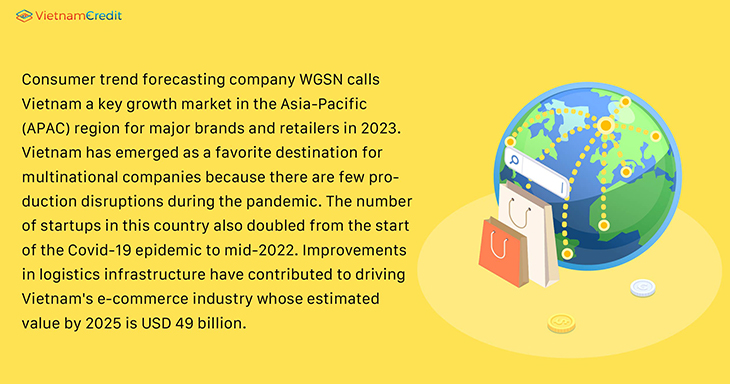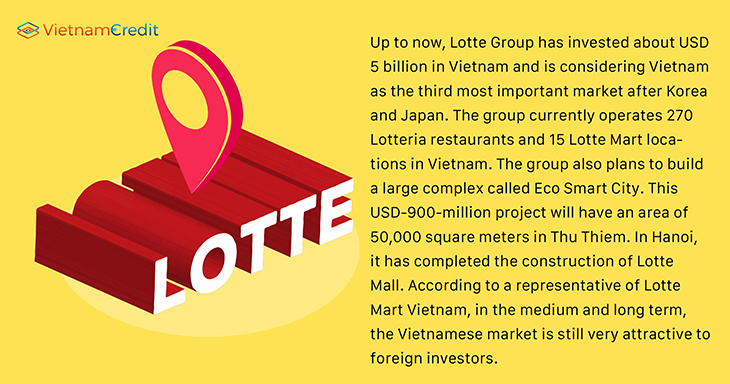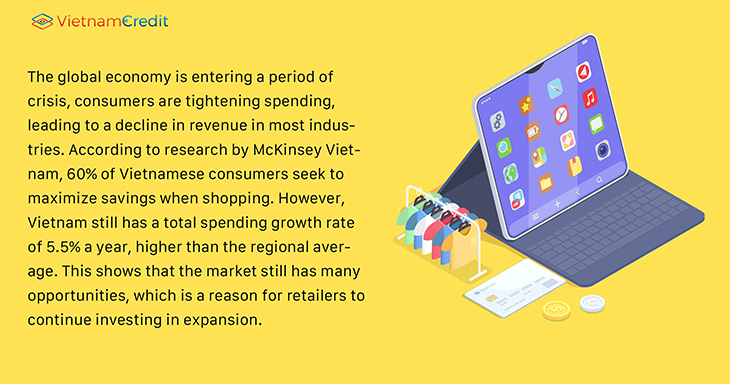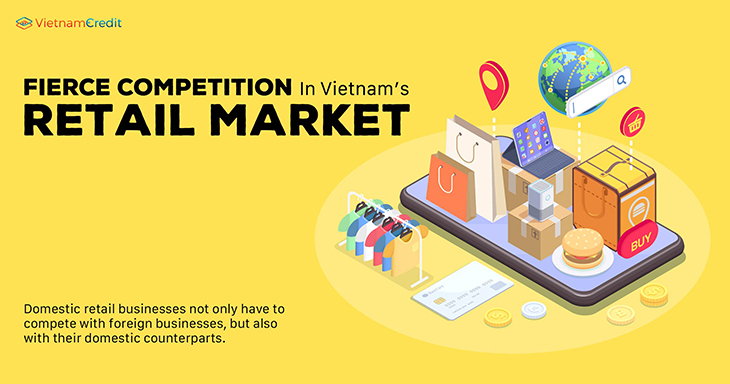Domestic retail businesses not only have to compete with foreign businesses, but also with their domestic counterparts.
Attractive market
Consumer trend forecasting company WGSN calls Vietnam a key growth market in the Asia-Pacific (APAC) region for major brands and retailers in 2023. Vietnam has emerged as a favorite destination for multinational companies because there are few production disruptions during the pandemic. The number of startups in this country also doubled from the start of the Covid-19 epidemic to mid-2022. Improvements in logistics infrastructure have contributed to driving Vietnam's e-commerce industry whose estimated value by 2025 is USD 49 billion.

According to the General Statistics Office, in the first 6 months of 2023, total retail sales of consumer goods and service were estimated to reach VND 3,016.8 trillion, an increase of 10.9% over the same period last year.
According to the Ministry of Industry and Trade, Vietnam's retail industry currently has a market size of USD 142 billion, and it is forecast to increase to USD 350 billion by 2025, contributing 59% to the total GDP. Specifically, traditional retail channels (markets, grocery stores) account for about 75%, while modern retail channels such as supermarkets or shopping centers account for about 25%. The potential of Vietnam's modern retail market is still very large, when the proportion in Thailand is up to 48%, the Philippines 75% and Singapore 80%.
The results of a survey of retail businesses show that over 53.8% of retail businesses have achieved business efficiency which is equal to or exceeding pre-pandemic levels. The growth of the retail industry has contributed greatly to the overall recovery of the economy, despite the unstable world situation. In particular, in the race to recover after the Covid-19 epidemic, the Vietnamese retail market witnessed the acceleration of businesses in applying digitalization to management, operations, logistics and distribution.
Trade experts believe that current retail revenue growth is supported by factors such as income growth, the strong recovery of the tourism industry, as well as related industries including transportation, accommodation and efforts to curb inflation.
Vietnam is being considered as an attractive retail market for foreign investors. According to a study by HSBC, by 2030, Vietnam's domestic consumer market will surpass that of Thailand, England and Germany. A recent survey by the Japan Trade Promotion Organization shows that 100% of Japanese retail businesses in Vietnam expect profits to grow in 2023. Among them, 80% of businesses said they will expand in the next 1 - 2 years.
According to KB Vietnam Securities Company (KBVN), the purchasing power of the retail industry is expected to recover from the last 6 months of 2023. Supporting that expectation is the Government's decisions to stimulate demand for the economy. Specifically, the State Bank has continued to reduce operating interest rates for the fourth time this year to support the economy, help businesses access capital to put into production and business, and create jobs for workers. In addition, the policy of increasing basic wages and reducing VAT also supports the retail industry. Specifically, from July 1, 2023, many groups of consumer goods were approved to reduce VAT from 10% to 8%.
Attract large capital
Up to now, Lotte Group has invested about USD 5 billion in Vietnam and is considering Vietnam as the third most important market after Korea and Japan. The group currently operates 270 Lotteria restaurants and 15 Lotte Mart locations in Vietnam. The group also plans to build a large complex called Eco Smart City. This USD-900-million project will have an area of 50,000 square meters in Thu Thiem. In Hanoi, it has completed the construction of Lotte Mall. According to a representative of Lotte Mart Vietnam, in the medium and long term, the Vietnamese market is still very attractive to foreign investors.

Central Retail - a retailer from Thailand - announced that it would invest an additional VND 20,000 billion in the Vietnamese retail market in the next 5 years. According to Central Retail, the plan is to pour more investment capital to boost sales in the Vietnamese market in the period 2022 - 2026 to VND 65,000 billion, aiming for multi-channel business in the field of food and shopping centers. Among the top Vietnamese retailers, Central Retail Vietnam has more than 340 stores with a total floor area of more than 1.2 million m2 in 40 provinces and cities. According to the expansion plan, Central Retail Vietnam aims to double the number of stores to 600 in 57 out of 63 provinces and cities in Vietnam by 2027, with a total floor area expected to reach 2 million m2. According to Central Retail, Vietnam is the market outside of Thailand that brings the largest revenue to the group, about 21-22% of total revenue. Last year alone, this figure was 25%.
Another retail chain from Thailand, MM Mega Market Vietnam, is also actively working with provincial and city governments to consider opening new points of sale, not only in big cities but also in level 2 and 3 cities to open smaller supermarkets with an area of about 2,000 - 3,000 m2 or open delivery centers for Horeca customers (hotels, restaurants).
With AEON Group, Vietnam is the country that AEON invests the most, with more than USD 1.18 billion. Regarding the upcoming plan, AEON will develop about 20 shopping centers in Vietnam, focusing on supermarket business and entertainment areas. In addition, this group also expanded the import of Vietnamese goods to distribute in more than 20,000 commercial centers in Japan. Not only opening large-scale shopping centers, AEON continuously joined hands with two large Vietnamese supermarket systems, Citimart in the South and Fivimart in the North, thereby creating two new joint ventures called Aeon Citimart and Aeon Fivimart.
It is forecasted that there will be 4 commercial center projects launched in 2023: Central Premium plaza, Vincom Megamall Grand Park, Sunrise City Central and Emart 2, contributing more than 116,000 m2 of new retail space.
Currently, Vietnam has about 1,085 supermarkets, 240 shopping centers and nearly 2,000 convenience stores. In particular, Vietnamese businesses account for about 70 to 80% of sales points nationwide.
Co.op Mart supermarket system is leading supermarket retail revenue (with about 130 supermarket sales) in the Vietnamese market, with sales of nearly VND 31,000 billion (2022), in which the e-commerce segment contributed more than VND 1,200 billion. This is the 6th consecutive year that Saigon Co.op's revenue exceeded the VND 30,000 billion mark. Currently, this business is focusing on improving service quality and expanding the distribution network to achieve a growth target of about 4% in 2023.
The Winmart+ system is continuing to promote restructuring when this chain is taken over by Masan from Vingroup. After closing some unprofitable stores, Winmart+ opened nearly 500 new stores. WinMart+ is currently the leading retail chain in terms of number of stores. As of March 2023, this unit owns 3,049 stores nationwide. According to the announcement of the 2022 business results report, the net revenue of WinCommerce (WCM), the owner of the Winmart+ and Winmart chains, was recorded at VND 29,369 billion.
The Bach Hoa Xanh chain of Mobile World Investment Company (MWG), due to reshaping its strategy, has closed many stores in 2022. Last year, the revenue of the Bach Hoa Xanh chain of stores was more than VND 27,000 billion with total 1,728 stores as of year-end. According to the latest data, in June 2023, the average revenue per Bach Hoa Xanh store in June reached VND 1.45 billion/store.
According to the Department of Domestic Market, Ministry of Industry and Trade, the Vietnamese retail system is dominating both in terms of presence in locations as well as total retail sales of consumer goods and service revenue. For example, the total area of domestic retail systems in shopping centers is up to millions of square meters, more than twice that of foreign retail systems.
Difficulties are opportunities
The global economy is entering a period of crisis, consumers are tightening spending, leading to a decline in revenue in most industries. According to research by McKinsey Vietnam, 60% of Vietnamese consumers seek to maximize savings when shopping. However, Vietnam still has a total spending growth rate of 5.5% a year, higher than the regional average. This shows that the market still has many opportunities, which is a reason for retailers to continue investing in expansion.

The number of self-service stores such as mini supermarkets is currently 4,000, but compared to Japan or other neighboring countries, it is still very small. Increasing the scale of modern retail channels will simultaneously strongly promote domestic production activities, shift modern and safe production models, ensure food safety and hygiene control, and develop new products by value chain, brand and sustainability.
According to experts, the two years of the pandemic can be compared to a market research period and this year is the right time for retail brands to launch expansion plans and breakthroughs in the race. Vietnamese people's consumption habits are gradually changing as they switch to shopping at the same place instead of going to traditional retail stores. Vietnam is also expected to offer retailers more business opportunities thanks to increased modernization of shopping experiences.
Besides, e-commerce in Vietnam has the potential to develop with an average annual growth rate of up to 25% (according to Vietnam E-Commerce White Book 2022, Ministry of Industry and Trade).
Vietnamese retail businesses are trying to keep their home advantage. They are constantly innovating management, brand recognition, restructuring product lines, applying technology, and improving sales. Advantages of Vietnamese businesses are the large number of supermarkets and stores located densely in residential areas with many flexible operating models. The government also has many policies on capital, stronger investment in commercial infrastructure contributing to promoting the development of domestic retail businesses.
Dr. Nguyen Thi Phuong (University of Industrial Economics and Technology), in her research "Solutions to improve the competitiveness of domestic retail enterprises", pointed out that domestic retail enterprises still have some limitation compared to foreign businesses. They are limited financial resources, no business strategy, weak professionalism and corporate governance. Only 5-7% of human resources in these businesses have been trained. Moreover, the connection between production and distribution is still loose and has not created strength.
Domestic retail businesses not only compete with foreign businesses, but also with domestic businesses. There is also competition between serious businesses and commercial fraud businesses.
Experts predict that within the next 2-3 years, Vietnam will have to completely open its retail market. This means foreign investors will have the right to establish retail companies with 100% foreign capital. Competition will become increasingly fierce to win billions of dollars in retail market share. Difficulties and challenges will also be opportunities for domestic retail businesses and investors from abroad.
Source: vietnamfinance
Compiled by VietnamCredit


























































